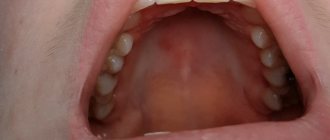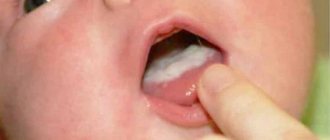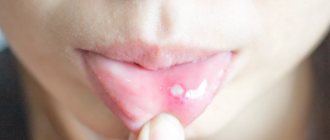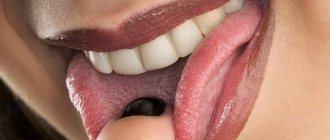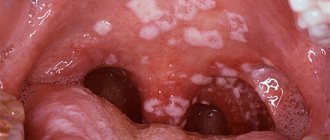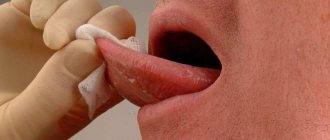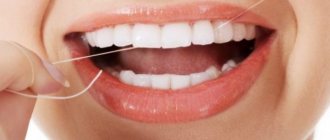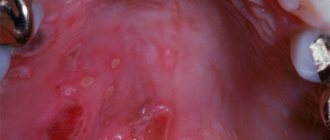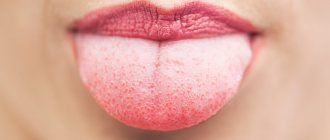The functions of the palate are important: participation in chewing food, pronunciation of sounds. Pain that occurs in the palate area negatively affects a person’s well-being and interferes with normal life activities.
It is believed that the condition of the oral cavity can indicate the presence of health problems in the body. When problems arise in the mouth - plaque, wounds, unpleasant odor, etc. - you should pay attention to your health. It also happens that the wounds heal on their own, but after a while they appear again. This may be a sign to see a doctor because the illness causing these problems may be serious.
It’s worth figuring out why the roof of your mouth hurts and what to do about it.
Topographic anatomy
The hard palate is formed by the palatine processes of the maxillary bones and the horizontal plates of the palatine bones.
The mucous membrane lining the bony base of the hard palate from the side of the oral cavity, near the dentition and along the palatal suture line, firmly fuses with the periosteum. Submucosal tissue is completely absent in these areas. Throughout the rest of the hard palate, the layer of submucosal tissue is weakly expressed, with the exception of the area along the line of transition of the alveolar process of the upper jaw into the palatine process. The blood supply to the hard palate is carried out by the large and small palatine arteries (aa. palatinae major et minor). The greater palatine artery, together with the nerve of the same name, emerges from the greater palatine foramen (foramen palatinum majus), the projection of which is 1-1.5 cm medial to the gingival margin of the third molar (Fig. 33). The lesser palatine foramen (the exit point of the artery of the same name) is located directly behind the greater palatine foramen. The anterior portion of the hard palate receives blood supply from the incisive artery (a. incisiva), which is a branch of the posterior artery of the nasal septum. Together with the incisive artery, the nasopalatine nerve (n. nasopalatinus) approaches the mucous membrane of the hard palate through the opening of the same name.
Initial and recurrent inflammation
Inflammation of the palate at the primary stage appears for a number of reasons that caused this pathology, and due to the activation of biological components-mediators at the damaged site.
Physiological processes occur in the mucous membrane of the palate, which are disrupted due to primary inflammation. As a consequence, destruction of cell membranes, transformation of structure, disruption of reactions.
Important ! Cells exposed to such destructive effects react differently.
During the development of the primary stage of pathological changes, decay products are released that interfere with normal blood flow and the functioning of cells of the nervous system. Mediators of the inflammatory process influence trophic and plastic factors.
The secondary stage is considered more severe: it enhances the effect of pathogenic agents, the localization of inflammatory mediators becomes the area around the previously affected area. Agents of secondary infection are present in cell membranes, and it is they that predict the further development of the disease and possible complications. There may be an accumulation of incompletely oxidized waste products - this occurs due to the activation of the protective functions of cells against pathogenic cells.
Technique for opening an abscess of the hard palate
1. Pain relief. When the abscess is localized in the anterior part of the hard palate, local infiltration anesthesia in combination with conduction anesthesia at the greater palatine foramen; when the abscess is localized in the posterior part of the hard palate - local infiltration anesthesia in combination with conduction anesthesia at the round opening according to S.N. Weisblat, or subtemporal anesthesia according to A.V. Vishnevsky against the background of premedication.
2. An incision in the mucous membrane of the hard palate through the inflammatory infiltrate along its entire length parallel to the course of the vascular bundle of the palate (Fig. 34).
3. Opening a purulent focus and evacuation of pus by spreading the edges of the wound using a hemostatic clamp.
4. Excision of a strip of mucous membrane 2-3 mm wide along the edge of the wound to ensure good constant outflow of inflammatory exudate without introducing drainage into the wound. Hemostasis.
Main causes of pain
There are many different causes for pain in the palate: internal pathologies, infections and functional disorders.
Discomfort may be associated with increased tissue sensitivity, a reaction to too hot or cold food, or poor oral hygiene. Even a small scratch can develop into a serious pathology due to a favorable environment for this. Dentists identify ten main reasons why their patients complain of pain in the palate:
- Bacterial infection. It becomes hyperemic, swells, a dirty gray coating appears on it, and ulcers and erosions appear on the mucous membrane.
- Sore throat and inflammation of the tonsils. Has similar symptoms to a bacterial infection. Neglected cases are fraught with severe complications in the form of myocarditis and polyarthritis.
- Stomatitis. Depending on the type of disease, ulcers, a dense yellowish coating, or herpes formations may appear in the mouth.
- Leukoplakia is a pathology of the oral mucosa that develops with constant temperature changes from food and drinks, and can also appear due to injuries to the mucous membrane. It is considered a precancerous condition.
- The consequence of smoking is that the mucous membrane is constantly exposed to the high temperature of smoke and its components. Smokers often develop Tappeiner's leukoplakia.
- Inflammation of the salivary glands - submandibular, sublingual or minor salivary glands - due to an infection in the mouth.
- Consequence of poor-quality prosthetics or unsuccessful treatment, tooth extraction.
- Pathologies of jaw joints, neuralgia. In this case, pain occurs not only in the palate, but also on the face, teeth and gums.
- Sialometaplasia is the appearance of a small benign tumor on the mucosa that causes pain. It grows to a certain size, then the bubble opens and a small wound forms.
- Domestic thermal and chemical burns of the mucous membrane that occurred due to negligence.
Inflammation of the salivary glands is one of the reasons
Each disease has its own specific symptoms. Not only doctors, but also patients need to know them. At least in order to determine which specialist to go to with your illness.
The appearance of ulcers on the oral mucosa indicates the development of candidiasis or thrush. Canker sores may have a cheesy appearance and are usually itchy and painful. Often they affect the entire tongue. Treatment of the disease is usually carried out with antimycotics and local treatment.
Candidiasis
With angina, the palate is hyperemic, swollen, the tonsils are enlarged and inflamed. Constant pain when swallowing increases sharply, and the patient's temperature rises. Sore throat can be different: catarrhal, follicular, etc. Effective treatment is only antibacterial, and it should last at least 10 days. This is necessary in order to avoid complications.
Angina
Pulpitis and periodontitis lead to tooth decay. They are accompanied by inflammation of the nerve bundles and severe throbbing pain. For treatment, the doctor must clean the dental canals and seal them. Periodontitis and other periodontal tissue diseases are treated by a dental hygienist. He will clean your teeth of plaque and tartar, rinse out the gum pockets and prescribe a course of antibiotics.
Signs of inflammation, redness of the gums and pain in the roof of the mouth may appear after tooth extraction. In this case, alveolitis can be suspected. This is suppuration and inflammation of the walls of the hole in which the tooth sits. This phenomenon occurs due to insufficient hygiene after surgery, when a protective blood clot falls out of the socket, or with reduced immunity.
Alveolitis
Leukoplakia is accompanied by a grayish coating on the palate and inner surface of the cheeks, and their swelling. There is roughness, tightness of the mucous membrane, moderate pain in the palate, burning in the mouth, decreased saliva production, and thirst. The pathology is sluggish, lasts for years, but has no reverse development. The plaque is replaced by keratinized areas raised above the level of the mucosa.
Leukoplakia on the palate in the initial stage
With benign tumors in the oral cavity, the palate does not hurt. They grow slowly and usually do not bother the patient until he accidentally notices them. However, any tumor must be shown to a doctor and removed as prescribed. There are many methods for painless removal: electrocoagulation, laser removal, radio waves, freezing with liquid nitrogen, sclerotherapy and others.
Pain also appears with pathologies of the temporomandibular joint. Inflammation of the bone structure causes sharp sharp pains in the palate, which intensify when opening the mouth and chewing. The soft tissues turn red and swell, a feeling of fullness appears in the joint area, and the temperature may rise. For this pathology, the doctor prescribes symptomatic treatment.
There are a number of symptoms, in the presence of which you need to see a doctor as soon as possible:
- decreased taste sensitivity;
- it became painful to chew and swallow;
- there was a feeling as if there was something in the mouth;
- mucous membrane is swollen;
- teeth are crumbling
- gums hurt and become very inflamed;
- ulcers or lumps on the roof of the mouth.
We invite you to familiarize yourself with the stages of dental implantation by time
Painful sensations in the palate cause a lot of inconvenience to a person. It happens that pain in the oral cavity can occur even when swallowing saliva or at rest, as well as when consuming food or drinks that irritate the oral mucosa. Such a manifestation may indicate both the presence of a serious disease or infection, and mechanical damage to the sensitive mucous membrane of the palate.
In diseases that cause damage to the palate, the following symptoms are observed:
- Acute painful sensations. Discomfort both at rest and when exposed to the mucous membrane of the palate. If you tolerate this manifestation, the pain will intensify to the point of difficulty swallowing.
- Painful sensations due to fungal infections in the oral cavity. Symptoms: the appearance of ulcers, erosions and plaque on the palate, cheeks and inside of the lip, and a burning sensation will be felt at the location of the ulcers. There may be a putrid odor from the mouth.
- Pain due to inflammation of the oral mucosa. Symptoms: redness and increased swelling, increased body temperature, chills, muscle weakness and increased salivation due to swelling of the tongue.
- Pain due to dental diseases. Symptoms: pain in teeth, gums, increased swelling of the cheek.
- Painful sensations when bacteria enter an open wound. Symptoms: pus formation, fever, nausea, migraine and fever. This condition is very dangerous and can lead to intoxication of the body.
- Oncological diseases. Symptoms: weakness, general malaise of the body, loss of appetite and swelling of the palate.
If at least one of the listed symptoms occurs, you should consult a specialist for advice. Only he will be able to make an accurate diagnosis and prescribe effective treatment aimed at eliminating pain and inflammation of the oral cavity.
The palate is the upper part of the oral cavity, which consists of two parts: upper and lower. This organ performs important functions: it takes part in chewing, is responsible for pronouncing sounds and forming the voice, and is part of the articulatory apparatus. Therefore, pain in the palate has an extremely negative effect on a person and prevents him from leading his usual lifestyle. Let's figure out why this disease occurs and how to deal with it.
There are many different causes for pain in the palate: internal pathologies, infections and functional disorders. Discomfort may be associated with increased tissue sensitivity, a reaction to too hot or cold food, or poor oral hygiene. Even a small scratch can develop into a serious pathology due to a favorable environment for this.
With benign tumors in the oral cavity, the palate does not hurt. They grow slowly and usually do not bother the patient until he accidentally notices them. However, any tumor must be shown to a doctor and removed as prescribed. There are many methods for painless removal: electrocoagulation, laser removal, radio waves, freezing with liquid nitrogen, sclerotherapy and others.
Pain in the palate occurs due to external and internal factors. External causes include irritation of the oral mucosa by chemical and thermal factors. Minor microdamages lead to inflammation of the palate, as they create an ideal environment for the proliferation of pathogenic flora. Dentists identify several main causes of the problem.
Infections
The provoking factors of the problem include pathogens of fungal, viral and bacterial origin. There are pathogenic agents in the oral cavity of any person, but they are activated only under favorable conditions: a decrease in general and local immunity; metabolic disorders; chronic diseases.
Fungal infection affects not only children, as many mistakenly believe, but also adult patients. The main symptoms of infection with yeast-like fungi are swelling of the soft tissues of the mouth and the appearance of a white coating on them.
The problems are complicated by secondary infection due to injury to the oral mucosa or poor hygiene.
The mucous membranes of the mouth are very thin, so hard and rough foods easily damage them. The same applies to cold and hot foods. The problem is often observed in adults and children who have the bad habit of biting their nails or putting foreign objects into their mouths. Violation of tissue integrity leads to the development of edema. The situation is complicated by poor oral hygiene.
Dental diseases that are not treated in a timely manner negatively affect the microflora of the mouth. In this case, gum inflammation is often accompanied by severe pain and swelling of the cheeks. The problem is caused by stomatitis, caries, dental cyst, periodontitis, osteomyelitis, pulpitis, periodontal disease.
Why does the sky hurt? Other causes of palate damage include:
- Leukoplakia. The condition is considered an early stage of the oncological process. Leukoplakia occurs due to temperature irritants and injury to the mucous membranes.
- Smoking. Under the influence of nicotine and tobacco smoke, the structures of the mouth undergo changes. As a result, a person experiences pain in the upper palate of the mouth.
- Poor quality treatment. Complications occur with improper prosthetics or after the removal of teeth damaged by caries.
- Degenerative processes of bone structures. In this case, unpleasant sensations spread to the joints and jaw.
- Sialometaplasia is a benign tumor that affects the mucous membranes of the mouth. The tumor gradually enlarges and then ruptures, leaving behind a large bleeding wound.
We invite you to familiarize yourself with Methods of installing dental implants
Topographic anatomy
The soft palate forms the posterior and partially upper walls of the oral cavity. The soft palate consists of a fibrous plate (palatal aponeurosis) with muscles attached to it and a mucous membrane covering them above and below. The anterior edge of the palatine aponeurosis is a direct continuation of the posterior edge of the bony base of the hard palate. The posterior edge of the soft palate ends with a uvula, the lateral side of which has a pair of palatal arches on each side. The anterior arch (arcus palatoglossus) is directed to the lateral surface of the posterior part of the tongue. The posterior arch (arcus palatopharyngeus) goes to the lateral wall of the pharynx. Between the arches is the tonsil fossa (sinus), in which the palatine tonsil (tonsilla palatina) is located. The muscular layer of the soft palate is formed by: m. tensor veli palatini, m. levator veli palatini, m. palatoglossus, m. uvulae (Fig. 35). The blood supply is carried out by the branches of the greater and lesser palatine arteries, the branches of the arteries of the nasal cavity, and the innervation is carried out by the branches of the pharyngeal nerve plexus. To m. tensor veli palatini is a branch from the mandibular branch of the trigeminal nerve.
If it's a sore throat
The source of the disease is a virus, transmitted by airborne droplets. The spots in the mouth grow instantly, forming one continuous redness.
Symptoms:
- abdominal pain;
- a sharp increase in temperature, maintaining high levels for several days;
- redness of the oral mucosa;
- copious amounts of saliva;
- increase in lymph node parameters;
- muscle weakness;
- pain when swallowing;
- red spots on the palate turn into bubbles with cloudy liquid;
- Erosion remains at the site of the opening of the blisters.
The patient is prescribed 4-6 times of gargling with antiseptics, anti-inflammatory drugs, antipyretics and painkillers. Children under one year old, as well as patients with complications, are sent to the hospital.
During the treatment period, it is necessary to exclude aggressive foods and foods with a hard structure from the diet, so as not to provoke injury to the inflamed mucosa.
Traditional therapy can be supplemented with folk remedies:
- drinking teas based on rosehip, lemon, raspberry;
- gargling with decoctions (sage, chamomile, linden, onion peel);
- resorption of honey;
- rinsing the mouth with beet juice, saline solution, garlic infusion.
Technique for opening an abscess of the soft palate
1. Anesthesia - local infiltration anesthesia (preliminary application anesthesia with a 1% dicaine solution can be performed) against the background of premedication.
2. An incision in the mucous membrane through the top of the inflammatory infiltrate (swelling) along its entire length parallel to the palatine arch (Fig. 36).
3. Separating the edges of the wound and moving towards the center of the purulent-inflammatory focus by tissue separation using a hemostatic clamp, evacuation of pus.
4. Since drainage in the wound of the soft palate is poorly maintained, in order to prevent premature adhesion of the edges of the wound, you can excise a strip of thinned mucous membrane along the edge of the wound 2-4 mm wide, or periodically spread the edges of the wound.
Did you like the article? Share with friends
0
Similar articles
Next articles
- Abcess and phlegmon of the tongue and sublingual area
- Abscess of the maxilloglossal groove
- Subperiosteal abscesses (periostitis) of the alveolar edge of the jaws
- Abscess, phlegmon of the zygomatic region
- Abscess, phlegmon of the buccal area
Previous articles
- Abscess of the nasal cavity
- Abscess, phlegmon of the orbital area
- Abscess, phlegmon of the chin area
- Abscess, phlegmon of the nose area
- Abscess, phlegmon of the mouth area
A child’s palate is inflamed - what to do?
Fungal infections are the most common cause of inflammation of the palate in children.
A child can injure the delicate mucous membrane of the palate by testing everything that comes his way. Such exploration of the world around us is a serious test for a baby’s mouth.
Important ! Gentle treatment is the key to the recovery of a small patient.
Can be used:
- rinsing with a weak salt solution;
- Furacilin solution;
- faint pink solution of potassium permanganate;
- Chlorhexidine solution.
Popular drugs for treatment
If the mucous membrane is slightly damaged, use warm herbal rinses with calendula, chamomile and sage. You can also use antiseptics - Chlorhexidine, Rotocan, Chlorophyllipt.
Combined dental gels are suitable for pain relief - Cholisal, Kalgel, Kamistad.
Of the antimycotics for candidiasis, the most often recommended are Candide, Pimafucin, Nizoral, Clotrimazole and the like.
For aphthous stomatitis of bacterial origin, sea buckthorn and rosehip oils are used, and for rinsing - propolis tincture, Romazulan, Miramistin, Stomatidin, Lugol. These agents accelerate the healing of mucous tissues.
For neuralgia, novocaine blockades, lidocaine, nonsteroidal anti-inflammatory drugs, and analgesics are prescribed.
For inflammation of the temporomandibular joints - anti-inflammatory treatment. Antibiotics and physiotherapy are used.
For burns, rinsing with lukewarm water and applications with Metrogil-Dent gel for pain relief are prescribed. To speed up healing, the palate is lubricated with sea buckthorn or rosehip oil and treated with tincture of calendula, Kalanchoe and other herbs.
If the mucous membrane is slightly damaged, use warm herbal rinses with calendula, chamomile and sage. You can also use antiseptics - Chlorhexidine, Rotocan, Chlorophyllipt.
Chlorhexidine Rotocan Chlorophyllipt
Candide Pimafucin Nizoral Clotrimazole
Sea buckthorn oil Rosehip oil Propolis tincture Romazulan Miramistin Stomatidin Lugol
Why does the roof of my mouth hurt?
Having figured out why the palate in the mouth hurts and how to treat it, or rather, in which direction to choose a therapeutic approach, let’s consider what needs to be done.
- rinsing with herbal decoctions with antibacterial properties;
- the use of solutions with local effects (Stomatofit, Rotokan, Miramistin);
- gargling with a soda solution;
- in case of an inflammatory reaction, you can take Summamed internally.
- will anesthetize and heal if there is damage Solcoseryl;
- Anesthetic sprays are suitable: Hexoral, Benzocaine.
- use anti-inflammatory gels: Cholisal, Kamistad;
- apply Acyclovir ointment.
- Borax (on glycerin) is applied.
- Chlorphilipt is used;
- Lugol's remedy.
To restore the protective function at the local and general level, vitamins are selected in combination with minerals. To maintain general condition, immunomodulators are indicated.
Long-term phenomena of unpleasant sensations require an in-depth study of the patient's system.
There are a large number of reasons that provoke the occurrence of pain in the oral cavity.
As a rule, this situation occurs due to careless consumption of solid foods or when coming into contact with food or drinks that are too hot. At the same time, wounds and scratches form in sensitive tissues. If hygiene rules are not followed, pathogenic bacteria can penetrate into them.
As a result, an inflammatory process develops in the oral cavity, redness and swelling appear on the palate, blisters and ulcers appear, which cause a lot of unpleasant sensations.
One of the main factors in the development of palate pain is inflammatory processes. When the palate becomes inflamed, bacteria actively multiply in the oral cavity, plaque and ulcers, redness and swelling appear. In this case, the patient experiences symptoms such as dryness, burning and pain.
Soreness of the palate can be one of the many symptoms of tonsillitis, tonsillitis and pharyngitis. In this case, the tonsils become enlarged, and the soft palate is involved in the general inflammatory process. Here, immediate treatment is necessary, since advanced cases of the disease can lead to serious complications.
Neuralgia
The soft palate contains many nerve endings. When jaw diseases occur, painful sensations affect not only the palate, but also other facial areas. In case of neuralgia, treatment can only be prescribed by an experienced specialist.
We invite you to read Beautiful teeth: how to achieve the desired result?
Pain can occur due to caries, pulpitis, after tooth extraction, prosthetics, filling, as well as due to the inflammatory process of the gums and palate or the appearance of any complications due to unqualified treatment.
If pain occurs after dental procedures and lasts for a short time, there is no need to worry, this is a natural process. If discomfort after visiting the dentist does not leave you for a day or more, you should contact another professional. If the root cause of the pain is eliminated, the discomfort in the palate will go away on its own.
Leukoplakia
Changes in the tissues of the oral mucosa occur with constant consumption of food that is too hot or too cold, or when the palate is damaged by objects or food with sharp edges. In this case, keratinization of the mucous membrane occurs, the palate becomes hard, dryness in the oral cavity and the appearance of a white coating are observed.
Sialometaplasia
The disease is characterized by the appearance of benign formations in the oral cavity. The bubbles grow to a certain size and then open, forming wounds.
Palate pain is one of the symptoms of this disease. Also characteristic symptoms are pain and swelling. After the wound has completely healed, the discomfort disappears.
Damage may be chemical or thermal in nature. Thermal burns can be caused by consuming hot food and drinks, and chemical burns can result from alkalis, acids and household cleaners accidentally entering the mouth.
Herpes
Herpes rashes can appear not only on the body, but also in the mouth and palate. This manifestation is observed quite rarely, but if it happens to you, you will have to deal with painful rashes and endure discomfort.
Due to the soreness of the palate, it is difficult for a person to eat and talk. Discomfort may occur even when swallowing saliva. In order to mitigate the symptoms of the disease, you need to know about the main causes of its occurrence and methods of treatment at home. It is also necessary to become familiar with the symptoms of pathology that require immediate medical attention.
Prevention of palate diseases
Basic prevention includes the following actions:
- balanced diet;
- correct and sufficient oral hygiene;
- rinsing your mouth after eating;
- cleaning the spaces between teeth with floss and dental brushes;
- giving up any type of smoking.
Now you know what to do if the roof of your mouth hurts. It is important not to forget that every six months a preventive examination by a dentist is necessary for timely treatment of oral diseases.
Mammals, when chewing food, form a food bolus in their mouth. They manipulate the food bolus using their teeth and tongue, pressing it to the palate. In order to fix the bolus of food in certain positions, the palate must be non-smooth. And when the lump moves to different ends, there is a certain number of clamps, which is why nature created transverse ridges in the palate.
All about your body Do tattoos increase the risk of skin cancer? Why do only Russians have a vaccine mark on their shoulder? What architectural and common sense mistakes have been made in the structure of the human body? Find out more
Inflammatory and infectious pathologies of the throat, gums, dental diseases, mechanical damage to the mucous membrane - all these are reasons that can provoke inflammation of the palate (palatinitis). As a result, pain occurs, the timbre of the voice is disrupted, and the pitch of the sound changes. The goal of treatment is to eliminate provoking factors and prevent serious complications with the help of medications and traditional recipes.
Inflammation on the palate
Causes of inflammation of the palate
Components of the palate:
- hard palate or upper palate - bone tissue, has an arched shape;
- soft or lower - consists of the mucous membrane.
Components of the palate
The main function of the organ is to prevent food from entering the nasal passage from the mouth. Additional responsibilities include participation in articulation through superficial receptors that are associated with the larynx.
The functioning of the palate can be affected by an inflammatory process that affects mucous tissues due to exposure to external irritants or dysfunction of internal organs.
Table “Causes of inflammation of the palate”
| External factors | Consuming hot foods or drinks, which can cause a burn to the mucous membrane (blue, swollen palate, bruising) |
| Negative effects of metals (braces, crowns) on a healthy oral environment | |
| The use of prostheses (friction of a foreign body on the mucous membrane over time can provoke wounds or ulcerative processes) | |
| Abuse of tobacco products | |
| Ignoring oral hygiene. If you do not brush your teeth or rinse your mouth for a long time, any mechanical damage (scratches, bruises) can allow infection to enter the body. | |
| Wounds, ulcers due to injury or an injection of anesthesia during tooth extraction (treatment). As a result, vascular spasm or ischemia occurs, which leads to a benign compaction - sialometaplasia | |
| Pathological conditions of the oral cavity | Fungal or bacterial infections, viral pathologies provoke a rash on the mucous membrane - enanthema (in a child it is expressed in the form of hyperemia of the mucous membrane, small pimples, ulcerations) |
| Development of infection in the bone tissue of the jaw (osteomyelitis) | |
| Seals of oncological etiology. Often found in adults with pathological immune disorders | |
| Damage to the joints of the jaw (upper or lower) due to the development of neurological abnormalities | |
| Upper respiratory tract infections (tonsillitis, sore throat, pharyngitis, rhinitis) | |
| Dental diseases (caries, periodontitis, stomatitis, pulpitis) | |
| Allergic manifestations to drugs | |
| Temporomandibular joint dysfunction |
Inflammation of the palate does not occur hidden. Usually the pain is pronounced, which makes chewing food very difficult and becomes acute when swallowing. Depending on the reasons that led to this condition, there are many symptoms of the disease.
- With fungi and bacteria (often happens in children under 1 year of age due to the fact that the child puts everything in his mouth) - a white coating and small ulcerations appear on the palate. The mucous membrane burns, hurts (especially while eating), and a putrid odor appears from the mouth. In adults, infection can develop after poor-quality tooth extraction, be a consequence of dental pathologies, or result from injuries.
- In case of throat diseases (tonsillitis, sore throat), the upper palate is red, there is swelling, the mucous membrane is loose. Swallowing is accompanied by pain and tingling, and severe irritation of the mucous membrane develops.
- With malignant tumors, the patient's palate hurts inside, with aching discomfort.
- After tooth extraction, bruising and swelling are observed closer to the teeth near the gums.
- In case of liver dysfunction, there is a yellow coating on the soft and hard palate, slight swelling and redness are possible.
- When you have a cold, the upper part of the oral cavity stings, cramps, and the mucous membrane is rough.
Inflammation of the palate often affects other parts of the oral cavity. A rash and swelling may appear under the tongue and behind the arches, on the inside of the cheeks, and behind the front teeth. In acute cases, the body temperature rises, hyperemia develops (intensive filling of blood vessels at the site of inflammation), and the mucous membrane dries out.
The photo shows what a healthy palate looks like and one affected by foci of inflammation.
Palate without deviations
Inflammatory process on the palate
Which doctor should I contact?
Negative processes in the oral cavity are treated by a dentist. If necessary, he can prescribe a consultation with a therapist and otolaryngologist, sometimes an oncologist (if there are tumors on the palate).
Diagnostics
To find out the factors that provoked inflammation of the palate, the patient needs to undergo a comprehensive examination:
- Examination of the oral cavity by a dentist and, if necessary, an otolaryngologist.
- Laboratory research. General and biochemical blood test, scraping (for seals on the palate).
- Ultrasound, computed tomography – for immune pathologies and diseases of the digestive system.
A blood test is done to identify the causes of inflammation of the palate.
If inflammation and pain are caused by dental disorders, you need to undergo an x-ray of the jaw to rule out purulent processes in the bone tissue.
Only after making a diagnosis can the doctor choose a special treatment that will be aimed at eliminating the source of the problem and improving the patient’s well-being.
Treatment at home
Pain and discomfort inside the oral cavity due to inflammation of the palate greatly worsens the patient’s normal life. Pharmacy medications and folk remedies as auxiliary therapy help alleviate the condition and cope with the disease.
Medicines
The main treatment depends on the original disease:
- For fungi and bacterial pathologies, it is recommended to use local preparations for rinsing the mouth and lubricating the mucous membrane - Chlorhexidine solution and gel, Rotokan, Stomatofit.
- For severe pain of various etiologies, local anesthetics are prescribed - Kalgel, Cholisal-gel.
- For purulent lesions, antibiotics are needed for oral use - Flemoxin, Sumamed.
Sumamed is an antibiotic agent
Important!
It is important not to delay treatment, but to immediately take the prescribed medications, strictly following the doctor’s instructions. Otherwise, there is a risk of serious complications.
Folk remedies
If wounds in the mouth do not heal for a long time, traditional medicine will help relieve inflammation in the oral cavity and relieve pain. Effective recipes help well in complex drug therapy.
Sage decoction
Brew 1 tsp in 250 ml of boiling water. herbs, simmer over low heat for 3 minutes, cool. Rinse your mouth with the strained solution 4–6 times a day. The course of treatment is until the unpleasant symptoms are completely eliminated.
Gargling with sage decoction will help relieve inflammation.
Oak bark decoction
Grind the raw materials and pour 2 tbsp into an enamel pan. l., pour 500 ml of boiling water. Boil in a water bath for 5-7 minutes, leave to infuse. Strain and rinse your mouth with warm broth every 2 hours.
Rinse your mouth with oak bark decoction every two hours
Raspberry leaf infusion
Finely chop raspberry leaves (2 tbsp) and pour a glass of boiling water. Rinse your mouth with the cooled liquid at least 5 times a day. For each manipulation it is necessary to prepare a glass of fresh infusion.
An infusion of raspberry leaves effectively relieves inflammation
St. John's wort tincture
Dry grass (150 g) pour 0.5 liters of vodka, leave for a week in a dark place. Take the medicine 35 drops with water. The product is also suitable for external use. Dilute 20 drops of solution in 50 ml of water and moisten a cotton pad and wipe the ulcerations on the palate.
St. John's wort tincture can be used for internal and external use
Viburnum berry decoction
Place dried berries (100 g) in boiling water (1 l) and boil for 15 minutes. Rinse your mouth with the cooled broth 3-4 times a day.
A decoction of viburnum berries is a good remedy for treating inflammation of the palate.
Chamomile and calendula infusion
Combine chamomile and calendula inflorescences in equal parts (1 tsp each). Pour two cups of boiling water over the vegetable mixture and leave to steep for 50 minutes. Thoroughly rinse your mouth and throat with herbal tea in the morning and evening.
Rinse your mouth with chamomile and calendula infusion morning and evening.
Propolis tincture
Dilute the pharmaceutical product in water at the rate of 10 drops per 200 ml of warm water. Rinse your mouth with the solution for 5–7 minutes every 2–3 hours.
To relieve inflammation on the palate, use propolis tincture
Folk recipes for inflammation of the palate are aimed at relieving swelling, redness and burning sensation. Herbal decoctions, infusions and tinctures produce antiseptic, anti-inflammatory, soothing and antimicrobial effects.
Possible complications
In most cases, inflammation of the palate is a consequence of external irritants or internal diseases.
Ignoring this condition can provoke undesirable consequences:
- destruction of bone tissue;
- tooth loss;
- purulent lesions of the gums;
- deformation of the upper part of the oral cavity;
- disturbances in voice timbre and changes in sound quality.
In severe cases, advanced stages can transform into malignant pathologies.
Ignoring palatal inflammation can lead to tooth loss
Prevention of inflammation of the palate
To avoid discomfort and pain that accompany inflammatory processes in the oral cavity, you need to follow simple rules of prevention.
- Brushing your teeth should be done in the morning and before going to bed at night.
- It is recommended to rinse your mouth after every meal.
- Avoiding very hot foods and drinks.
- Limit smoking and alcohol consumption.
- Eat a balanced diet. There are foods rich in microelements and vitamins (vegetables, fruits, fish, meat, beans and soy).
Rinse your mouth after eating
Prevention helps strengthen local immunity, establish metabolic processes in the body, maintain a healthy environment in the oral cavity and strengthen the body as a whole.
Inflammation of the upper and lower palate can be caused by dental diseases, infectious pathologies of the throat, gums, bad habits and poor oral hygiene. The disease causes severe pain and worsens a person’s quality of life, as it interferes with chewing food, speaking, and swallowing. To prevent the disease from worsening, it is important to consult a doctor on time and receive proper treatment.
Teeth and mouth
Rate the article (ratings, average of 5)
Many people experience painful sensations if the roof of their mouth is inflamed, and do not know how to treat this condition; its possible causes, photos and methods of struggle can be found in this article.
The palate has an important functional significance for the body: it separates the nasal cavity from the oral cavity, helps to chew and swallow food without choking, clearly reproduces speech sounds, and participates in the formation of the voice. Anatomically, the palate is divided into two parts: hard, located closer to the teeth, and soft, smoothly passing into the pharynx. Both of these sections can become inflamed, but these conditions will manifest themselves in different ways.
Symptoms
Candidiasis
Angina
Alveolitis
Among the main signs characteristic of inflammation of the palate (regardless of the cause) are:
- pain of varying intensity;
- increase in the size of the sky;
- changes in the structure and color of the mucous membranes;
- discomfort while eating;
- rough palate syndrome.
A significant increase in size of the area may indicate an allergic reaction. It occurs due to intolerance to food, medications or dental care products. Painful sensations are complemented by burning and itching. To relieve symptoms, it is recommended to take antihistamines.
Bleeding soft tissues indicate the introduction of bacterial flora into them. In this case, the symptom may be complemented by toothache.
Dangerous symptoms
Diseases that cause damage to the mucous structures of the mouth have a negative impact on overall health. Some symptoms should be a reason to see a doctor if the roof of your mouth hurts. The list of dangerous signs includes:
- loss of sensitivity of mucous structures;
- change in taste sensations;
- discomfort in the throat while swallowing (a symptom may indicate the development of a purulent sore throat);
- significant swelling of the mucous membranes;
- tooth decay;
- the presence of sores on the gums;
- seals with a modified structure, palpable on the tongue.
Diagnostics
If characteristic symptoms occur, it is not recommended to delay contacting a specialist. Timely assistance can prevent the occurrence of complications and various pathologies, and alleviate the painful condition. First of all, the doctor, based on a thorough examination and complaints of the patient, finds out the causes of painful sensations in the palate.
After this, the therapist prescribes a culture from the oral cavity and a complete blood test. After receiving the results, the examinee is sent to a specialist with a narrow specialization: otolaryngologist, dentist, oncologist. The patient is also recommended to undergo a full examination of the body in order to identify the presence or absence of damage to internal organs.
When to see a specialist
At the slightest manifestations that cause discomfort and anxiety, you should consult a specialist. But not every person will act in this way when the slightest change occurs in the functioning of the body. You should be concerned if:
- increased pain;
- increased swelling and inflammation;
- increased body temperature;
- crumbling and softening of dental tissue;
- the appearance of erosions and compactions in the sky;
- weakening of taste sensations;
- severe pain when eating food and liquids;
- the appearance of suppuration.
If treatment is not started in time, this can lead to the disease moving to a more complex stage, so you should not endure the pain and ignore the symptoms.
